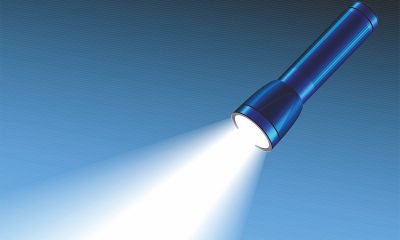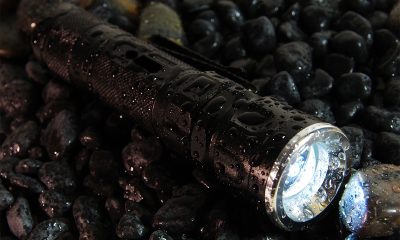Blazingly bright flashlights
High lumen LED flashlights are luminous workhorses that can churn out tens of thousands of lumens from a battery powered LED light engine to deliver powerful lighting at your fingertips. Flashlights with a minimal light output of 6,000 lumens are herein called high lumen LED flashlights or super bright flashlights. The most powerful flashlights can produce a blazingly bright output of up to 160,000 lumens. These beasts can throw a long beam far out in the distance and are intense enough to cut through thick fog, smoke and dust. When switched to the wide flood mode that is available in some products, the powerful beam can create a large field of view to cover a massive area thoroughly for mission-critical visibility. With exceptional portability and ultra-bright illumination, high lumen LED flashlights are unmatched choices for searching, rescuing and tactical applications.
The luminous power of LEDs
It is only when LED technology pushed the boundaries of lighting performance that the development of powerful flashlights became a possibility. LEDs make use of semiconductor electroluminescence to generate light. When a sufficient forward bias is applied across the p-n junction, electrons from the n-doped semiconductor layer will drop down from the conduction band and recombine with holes from the valence band of the p-doped semiconductor layer in the active region of the diode. Radiative electron-hole recombination releases electromagnetic energy that is perceived as visible light by the human eye. The narrow-band emission is utilized to pump the phosphor down-converter within the semiconductor package to produce white light.
Semiconductor-based light-emission mechanism yields an enormously improved efficiency in conversion from electrical to optical power. The LED technology platform makes it possible to create high flux density light sources that deliver a breakthrough combination of lumen output and luminous efficacy in a small package. By way of example, a Cree XLamp XHP70.3 LED which is 7 x 7 mm in size can produce 4,000+ lumens of blinding bright white light while drawing only 4,800 mA of DC forward current (6 V). High lumen density, low energy consumption, optical directionality, small source footprint and solid state durability give LEDs a competitive advantage in battery powered portable lighting applications.
LED package technology
A high lumen LED flashlight is a complex system which integrates multiple components to produce light. Its performance and lifetime are heavily dependent on the interrelated components. The LED package selection defines many luminaire performance variables such as luminous efficacy, color rendition, and color temperature. In order for these performance variables to remain consistent over the service life of a flashlight, the light source must be able to survive operational stresses.
In integrating LEDs into a system, the first priority is to select the LEDs with proper electrical, photometric and thermal characteristics which are tightly interdependent. A super bright flashlight incorporates multiple high power LED packages to achieve the required lumen package. Presently the most used high power LEDs are ceramic packages that mount the LED chip to a metallized ceramic substrate. A ceramic substrate has excellent dielectric strength for electrical insulation and its high thermal conductivity enables effective heat transfer from the active region of an LED to the system thermal conduction interface. Not all LEDs are created equal. Top flashlight brands have been giving preference to Cree XLamp LEDs which are built on the silicon carbide (SiC) technology. With the GaN layers deposited on a SiC substrate, Cree’s products exhibit a remarkably lower density of threading dislocations than those fabricated on a silicon or sapphire substrate. Threading dislocations are defects in the semiconductor crystalline structure. A high density of such defects compromises LED efficacy and lifespan. Cree’s GaN-on-SiC devices come with significantly less mismatched lattice and coefficient of thermal expansion (CTE), allowing them to deliver high efficacy and excellent lumen maintenance even under high thermal and electrical stresses.
The most recent evolution in LED package design is the CSP technology. By removing as many of the packaging elements found in ceramic high-power LEDs as possible, CSP LEDs provide a higher efficiency thermal path to extract heat from the LED junction, which in turn offers the LEDs high drive current capability needed for high lumen lighting applications.
Thermal management
As an integrated lighting system, an LED flashlight is capable of reaching high performances and delivering high reliability only when all its subsystems are coordinated to provide an optimal operating environment for the LEDs. LED lighting creates a challenge in thermal management, in particular for high lumen LED flashlights where high power operation is required.
Despite the tremendously improved source efficiency, more than 50% of electrical power fed to an LED is dissipated as heat due to non-radiative recombination of injected electrons and holes, efficiency droop owing to operation at higher current density in InGaN LEDs, and losses resulting from incomplete extraction of light generated within the semiconductor package. In order to get the legendary longevity and energy efficiency out of the LED technology, the LED junction temperature must be maintained at all times. Overheating the LEDs will accelerate the growth of intracrystalline defects, which leads to irreversible damage.
Passive cooling is always preferred due to its reliability, low power and silent acoustics. The LED module of a high lumen LED flashlight is an assembly of LED packages on a metal core printed circuit board (MCPCB) which serves to spread heat across a heat sink over a larger area. A thermal interface material (TIM) may be interposed between the PCB and heat sink to maximize the heat flow. The heat sink is fabricated from a high thermal conductivity material such as aluminum and designed with as much surface area as possible to maximize natural convection of heat.
The dimensional constraint of the flashlight heat sink calls for thermal transfer capabilities beyond conventional aluminum heat sinks. Heat pipes may be added to heat sinks to facilitate the heat dissipation. When the thermal load of the LED module is too high to be handled by passive cooling elements, an active cooling system that creates forced air convection with a fan will be used.
Rechargeable battery
High lumen LED flashlights are generally powered by high-capacity rechargeable lithium-ion (Li-ion) batteries. Lithium-ion batteries have virtually become the industry standard for mobile devices because of their superior performance. The cathode and the anode of these electrochemical systems have structures that allow reversible insertion and extraction (intercalation and de-intercalation) of lithium cations. These dual intercalation systems boast the highest energy density when compared with all conventional batteries that have been used to power flashlights. These batteries include the primary alkaline cells and the secondary nickel-cadmium (NiCd) and nickel metal hydride (NiMH) batteries.
Of all the rechargeable systems, lithium-ion batteries have the lowest self-discharge rate, highest charging efficiency, and longest cycle life even at a high depth of discharge (DOD). These rechargeable batteries do not suffer from memory effects as the NiCd batteries do. When incorporating lithium-ion batteries into flashlights, however, safety circuitry must be in place to protect the electrochemical cells against damages due to overcharging, overdischarging, short circuiting, physical damage, or exposures to elevated temperatures. Super bright flashlights commonly use several 21700 or 18650 battery cells, or run off built-in battery packs.
All these lithium-ion batteries must incorporate battery management circuitry to monitor and control battery operation. An integrated USB charging port is usually provided for convenient and fast charging. Removable battery packs can be charged independently. A rechargeable flashlight generally has a built-in battery indicator that allows the user to keep track of usage and the charging status.
Drive current regulation
The high power LED module is operated by a constant current driver circuit which regulates battery power to the LEDs. The LED driver is configured to produce a sufficient forward voltage and provide appropriate current to drive the LEDs for consistent brightness under load variations. Maximizing the operational efficiency of the driver circuit is a priority due to the relatively high wattages involved.
Most LED flashlights can operate in different modes such as light output in different levels (turbo, high, medium, low), strobe and SOS. These functions must be accomplished through an LED driver with dimming controllability. The driver may be designed to support pulse-width modulation (PWM) or constant-current reduction (CCR) dimming for adjusting the light intensity. A microcontroller is usually integrated into the LED driver to provide control logic and enables implementation of the user interface.
Construction
An anodized aircraft aluminum housing provides ruggedness and aids in thermal management. Optical regulation is provided by precision machined aluminum reflectors which are chosen for their higher thermal stability over polymer lenses. The high-power LED architecture often delivers the most thermal stress to the phosphor and binder materials due to the additional Stokes heat generated in the phosphor matrix during phosphor conversion. The entire luminaire may be sealed against the ingress of dust and water so it can be used outdoors in all weather.

















Loading...